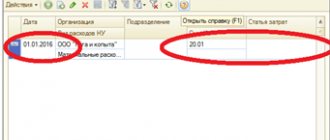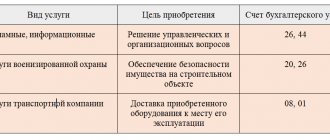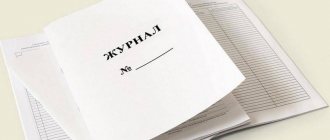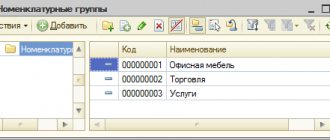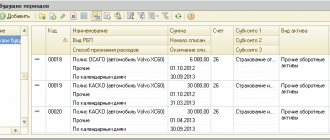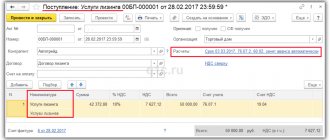Direct and indirect costs
Direct costs are costs associated with the production of a particular type of product (performing certain works, providing certain services), which can be directly included in the cost of these products (works, services).
Indirect costs are costs that are associated with the production of several types of products (works, services). They cannot be directly attributed to a specific type of product.
Let's consider how direct expenses should be reflected correctly in accounting and tax accounting during production, provision of services or performance of work in 1C: Enterprise Accounting 3.
Posting of indirect expenses written off to cost
Setting up the distribution of indirect expenses, with “For production costs” selected, is similar to the distribution of direct expenses. This operation is carried out in the “Distribution of expenses for product cost” work place, and the redistribution base depends on the setting of the expense item.
Fig.4 Workplace for distribution of expenses
It supports setting up distribution by stages or divisions of production, and, depending on the selected option, the process is either fully automated, or the user at the workplace must manually fill out the redistribution base (either stages, or divisions, or both).
The actual entry of such expenses into the cost price is carried out during the month-end closing procedure, together with the operation “Distribution of income and expenses by areas of activity.”
Direct expenses in accounting in 1C 8.3
In accordance with the instructions for using the Chart of Accounts, approved. By order of the Ministry of Finance of Russia dated October 31, 2000 No. 94n, direct expenses in accounting (BU) are those expenses that, in the production or provision of services, are reflected in the debit of accounts 20 “Main production”, 23 “Auxiliary production” and 29 “Service production and facilities” . The balance of direct expense accounts at the end of the month shows the value of work in progress.
To reflect 20 direct expenses on the debit side of the account for accounting in 1C: Enterprise Accounting 3.0, you must set the parameters in the Accounting Policy (Fig. 1)
The flag indicates those types of activities, the costs of which are planned to be accounted for on account 20 (for the production of products and (or) performance of work and provision of services to customers). The checkboxes are checked in order to keep or not keep records of direct expenses in accounting as a debit to account 20.
If this expense is direct according to the accounting policy of the organization, then in the transactions in 1C: Enterprise Accounting 3.0 you need to reflect the expense on the debit of account 20.
Sharp corners
Accountants more than once encounter situations where quite logical and seemingly easy legal norms cause difficulties in practice. So this issue is not without its sharp corners, which are easy to stumble upon. We will try to smooth them out. What you might encounter:
Easy to organize.
The taxpayer's expenses attributable to direct expenses that he incurs during forced downtime should be taken into account as part of non-operating expenses (clause 2 of Article 265 of the Tax Code of the Russian Federation). Indirect expenses that the taxpayer continues to incur during forced downtime are taken into account for profit tax purposes as part of the corresponding groups of expenses (letter of the Ministry of Finance of Russia dated September 21, 2010 No. 03-03-06/1/601).
Changes at the beginning of the year.
A situation may arise when, from the beginning of the year, the organization decided to change the list of direct expenses, fixing it in its accounting policies. Due to these changes, part of the costs that were previously direct will be considered indirect from the beginning of the year. The question arises: what to do with the direct costs accumulated by the end of the year, awaiting implementation, which have been reflected in the accounting policy as indirect since the beginning of the year? According to the Ministry of Finance, such costs, which fall on work in progress and unsold products, will not be taken into account. In the new tax period, they will also have to be written off as goods (work) are sold. And you can write off at a time only those costs that have been incurred since the beginning of the new tax period (letters of the Ministry of Finance of Russia dated September 15, 2010 No. 03-03-06/1/588, dated May 20, 2010 No. 03-03-06/1 /336). It is difficult to argue with officials, because direct expenses relate to the expenses of the current reporting (tax) period as they are realized. And since such expenses have already formed the cost of unfinished or unsold products, they will have to wait for sale. And changing the accounting policy from the beginning of the year will not allow them to be written off at once.
No revenue.
An organization has the right to write off direct expenses for profit tax purposes only in the period when revenue is reflected in taxable income, therefore it will not be possible to recognize direct expenses without sales, and therefore without revenue (letter of the Ministry of Finance of Russia dated April 9, 2010 No. 03-03-06/1 /246). But the Tax Code allows indirect and non-operating expenses to be written off at a time in the period in which they were incurred (clause 2 of Article 318 of the Tax Code of the Russian Federation). That is, in the absence of revenue, indirect expenses are recognized as losses, which will reduce the income received later (letter of the Ministry of Finance of Russia dated March 6, 2008 No. 03-03-06/1/153). But in practice, organizations have to defend the right to write off indirect costs, since officials often confuse the lack of sales in a specific period with the lack of commercial activity in general. Thus, in one resolution, judges explained to tax authorities that the lack of income in the reporting period cannot be a basis for refusing to recognize indirect expenses incurred by the taxpayer (Resolution of the Federal Antimonopoly Service of the Moscow District dated March 31, 2010 No. KA-A40/2740-10 in case No. A40-93652/09-127-559).
The easiest thing in this situation is for organizations that provide services. They have the right to completely write off both direct and indirect expenses in the current period, regardless of receipt of revenue (letter of the Ministry of Finance of Russia dated August 31, 2009 No. 03-03-06/1/557).
Often, regulatory authorities try to recognize expenses as economically unjustified if the taxpayer did not receive income or suffered a loss in the reporting (tax) period. But officials do not take into account that the proceeds received from sales may not cover the expenses incurred. This does not equate to the fact that the organization did not conduct activities and did not receive revenue. It’s just that the financial result may be negative. And revenue should not be confused with income. Both officials of the financial department and judges speak about this: if the expenses incurred meet the requirements of Article 252 of the Tax Code, then they are taken into account when determining the tax base for income tax, regardless of the presence or absence of income from sales in the corresponding tax period (letter of the Ministry of Finance of Russia dated 25 August 2010 No. 03-03-06/1/565, resolution of the Federal Antimonopoly Service of the Central District dated February 9, 2010 in case No. A14-14803/2008/500/24).
Direct costs on hold.
If during the reporting (tax) period the taxpayer does not have transactions for the sale of goods recognized as objects of VAT taxation in the main type of activity, but carries out other types of activities that are subject to taxation, VAT deductions on purchased goods (works, services), including to be used in the main type of activity are carried out in accordance with the generally established procedure (letter of the Ministry of Finance of Russia dated October 12, 2010 No. 03-07-11/402).
Material prepared by S. Shestakova
Indirect costs in accounting in 1C 8.3
In accounting, indirect costs are usually understood as general production and general business (administrative) expenses, which are recorded, respectively, in accounts 25 “General production expenses” and 26 “General expenses”.
Indirect costs are distributed among the cost of manufactured products (works, services) and reduce profits at the time of its (their) sale. Commercial organizations can recognize management expenses in the period of their occurrence (clause 9 of PBU 10/99).
And if the procedure for dividing expenses into direct and indirect in accounting is determined by the correspondence of accounts, then for tax accounting purposes in 1C Enterprise Accounting 3.0 direct expenses can be reflected in different accounts 20, 25, 26 and do not depend on correspondence. And here it is important for the accountant (user) to correctly determine and configure the composition of direct expenses in the 1C: Enterprise Accounting 3.0 program, because tax accounting data is used in calculating income tax.
Read more
Write-off to the cost of finished products
Since expenses must be included in the cost of finished products (which naturally means manufacturing companies), in 1C ERP this setting is available only for items that have “For production costs” selected as a redistribution parameter in accounting. Because the classification is only relevant for tax purposes, the posting option you select for the adjustment does not affect the availability of that classification.
Fig.2 Setting up redistribution in accounting
After selecting the “For production expenses” option for accounting, the option for classifying expenses becomes available in the article on the “Regulating and MFP” tab.
Fig. 3 Classification of expenses for determination purposes
Further allocation of costs to cost depends on the allocation base, which is formed in the process of reflecting production operations in the system. Fixation of planned and actual material and itemized costs is carried out in the context of stages. Calculation of the cost of finished goods (including indirect expenses) is carried out in the same way, on the basis of executed documents “Stages of Production”. The following manufacturing cost calculation options are supported:
- The product was produced during the period in which the cost was recorded. In this case, all accumulated costs for the production stages at which the release occurred are summed up and redistributed to the manufactured goods in proportion to the cost shares established in the resource specifications.
- The release of goods for the production stage was not carried out in the current month, for example, the production stage to which indirect expenses were allocated did not lead to the release of goods. Here, the division of expenses into manufactured goods is carried out individually for each time period (month), taking into account planned data on the consumption of materials and planned data on the release of finished products.
REGISTER FOR CALCULATION OF TAX "UNCOMPLETE".
Due to the fact that account balance 20 shows the value of work in progress at the end of the reporting period in accounting, tax expenses of the main production are inextricably linked with this asset, which has to be tax assessed. It is based on a register that is formed using data obtained not only from the tax register of account 20. Information from registers for writing off direct material costs and depreciation deductions will be useful. We will not collect data from all the above calculations - not only because it is labor-intensive. Calculations may confuse the reader and may not provide a true picture of the tax gap. Let's present numbers from practice.
| Name of expense item | Balance at start | Coming | Total expenses | KNZP | WIP balance in cost estimate | Amount of production costs |
| 1 | 2 | 3 | 4 | 5 | 6 | 7 |
| 1. Direct costs in the planned cost (estimated data) | 7 143 263 | 10 938 609 | 18 081 872 | 0,9467 | 7 794 113 | 10 287 760 |
| 2. Actual direct costs (accounting data) | 6 782 333 | 10 336 113 | 17 118 446 | 7 378 686 | 9 739 422 |
Let us explain the calculations in the register. The first line provides planned data on direct costs attributable to “work in progress”. The economist calculates them in the auxiliary register, based on documents on the movement and balances (in quantitative terms) of raw materials and materials, as well as information on direct planned expenses of the previous period. For the calculation, ready-made data from the planning department and actual data on expenses from accounting (account 20) are used, and only direct expenses are selected. Indirect costs are excluded from the calculation of “work in progress”. Let’s say that in the example, direct costs include raw materials, depreciation, wages and contributions from them to extra-budgetary funds. Total direct expenses for the reporting period RUB 18,081,872. (according to planned data) and 17,118,446 rubles. (according to actual accounting data). Knzp is a coefficient reflecting the share of actual direct costs in similar planned costs; in the example it is equal to 0.9467 (17,118,446 / 18,081,872). Based on the coefficient, the balance of actual direct expenses remaining in the “work in progress” is calculated - RUB 7,378,686. (RUB 7,794,113 x 0.9467), at the end of the current month it is included in the direct expenses of the next month. The other part of direct costs (RUB 9,739,422 = 10,287,760 x 0.9467) is included in the cost of finished products. This indicator is used in another tax register, which is filled out by an enterprise that has balances of unsold products in its warehouse. But this register has nothing to do with counting 20.
TAX REGISTER FOR CALCULATION OF DEPRECIATION.
You cannot do without this register, because in tax accounting there is such a preference as a depreciation “premium” (writing off part of the cost of fixed assets at a time). In addition, tax accounting establishes depreciation groups between which depreciable property should be distributed. In accounting, the business entity independently sets the useful life during which the cost of the fixed assets is transferred to the expenses of the enterprise. And most importantly: in accounting it is important to objectively determine the current value of fixed assets, while in tax accounting priority is given to writing off actual expenses associated with capital investments to reduce taxable profit.
Taking into account the above, the tax register for calculating depreciation (“Rn-Amort”) may be as follows (we provide a greatly abbreviated and simplified version).
Register of depreciation of fixed production assets
| Name of depreciable property | Amount of capital investment | Share of capital investments | Depreciation bonus | Tax value of property |
| Product packaging line | 7 714 286 | 30% | 2 314 286 | 5 400 000 |
| Manufacture building | 50 000 000 | 10% | 5 000 000 | 45 000 000 |
| Name of depreciable property | Depreciation method | Depreciation period | Exploitation | Remaining useful life | |
| Term | Amount, rub. | ||||
| 1 | 2 | 3 | 4 | 5 | 6 |
| Product packaging line | Linear | 72 months | 36 months | 2 700 000 | 36 months |
| Manufacture building | Linear | 300 months | 100 months | 15 000 000 | 200 months |
Let us explain the information given above. The depreciation bonus for object 1 will be equal to RUB 2,314,286. (RUB 7,714,286 x 30%). The tax value after deducting the premium is RUB 5,400,000. (7,714,286 – 2,314,286). The amount of monthly depreciation for the line for packaging and packing products is 75,000 rubles. (5,400,000 / 72 months). Over 36 months, depreciation will be 2,700,000 rubles.
Similarly, for the second facility (industrial building), the depreciation bonus will be 5,000,000 rubles. (RUB 50,000,000 x 10%). The tax value after deducting the premium is RUB 45,000,000. (50,000,000 - 5,000,000). The amount of monthly depreciation of an industrial building is 150,000 rubles. (45,000,000 / 300 months). Depreciation for 100 months will be equal to 15,000,000 rubles. (RUB 150,000 x 100 months).
The amount of monthly depreciation for both main production facilities is written off to the tax “work in progress” calculation register. Moreover, the Rn-Amort tax register may also reflect objects of other industries, the depreciation for which will be an indirect expense for tax purposes. In this case, the accountant needs to separate “direct” and “indirect” depreciation. The register for calculating the “work in progress” will obviously include the amounts of direct depreciation charges.
Distribution of overhead costs
Let us determine the basis for the distribution of general production costs for each division (production cost item “Payment of production workers”). See table 4:
Table 4
Let's calculate the distribution of overhead costs using the following formula:
SOPRvn = OPRp * BRpvn / BRp, where
- SOPRvn - the amount of overhead costs distributed by type of item;
- OPRp - general production expenses for the division (debit of account 25);
- BRp - distribution base for the division as a whole;
- BRpvn - distribution base by division and type of item.
The complete distribution table is as follows:
| Type of nomenclature | Subdivision | |
| Workshop No. 1 | Workshop No. 2 | |
| Cabinets for radio equipment | 15000 * 20000 / 50000 = 6000 | 35000 * 30000 / 90000 = 11666.67 |
| Bedside tables | 15000 * 30000 / 50000 = 9000 | 35000 * 60000 / 90000 = 23333.33 |
Specifics of different companies: how not to confuse indirect costs with direct ones
The previous section examined a type of expense that can be equally classified as indirect and direct. And this is not the only case where direct and indirect costs are intertwined. At the same time, there are often situations when the same expense for one company can only be indirect, and for another - only direct.
One such example is the company’s costs for product packaging. The following court decisions have confirmed the unambiguous location of such expenses as follows:
- indirect - when the company was engaged in the production of paper and, upon completion of production, packaged the finished product (roll paper) in packs and boxes (Resolution of the Federal Antimonopoly Service of the North-West District dated June 20, 2011 No. A56-46595/2010);
- direct - when the company used containers in the production of alcoholic products: bottling alcoholic products into glass containers is one of the stages of production (Resolution of the Presidium of the Supreme Arbitration Court of November 2, 2010 No. 8617/10).
“Accounting for returnable packaging: price, postings, taxes” will tell you what nuances of working with returnable packaging need to be included in the UP .
Thus, an initial adequate and logical justification (in accordance with the technological process) for including a particular expense among indirect and direct expenses will allow any company in any situation to defend its case before controllers and (or) judges.
TAX REGISTER OF COSTS OF MAIN PRODUCTION.
Any accountant has a good idea of what a balance sheet looks like for a particular accounting account. One of its main advantages is that the details of the account are visible. In particular, for cost accounts, analytics are provided in the context of cost elements (items).
| Naming of expenditures | Number of correspondent account | Account turnover | Amount accepted for calculation | Amount not accepted | Note (included in other registers) |
| Raw materials | 10 (15, 16) | 5 000 000 | – | 5 000 000 | From register "RN-MPZ" |
| Staff salaries* | 70, 96 | 1 000 000 | 1 000 000 | 200 000 | To register "Rn-NZP" |
| 200 000 | |||||
| Insurance premiums for employees | 69, 96 | 300 000 | 300 000 | 60 000 | To register "Rn-NZP" |
| 60 000 | |||||
| Depreciation of fixed assets | 02 | 50 000 | – | 50 000 | From register "Rn-Amort" |
* The reader may be surprised that for wages (and insurance premiums) of the main production personnel, not only accounts 70, 69, but also account 96 are corresponding. These are estimated obligations for the vacations due to them. Chapter 25 of the Tax Code of the Russian Federation allows you to reserve expenses for vacation pay - but according to rules that differ from the accounting rules, in which the main thing is not to evenly distribute vacation expenses, but to show the obligation to pay them as of the reporting date. Accordingly, the accounting “vacation” reserve is not accepted for tax purposes.
Let us explain the filling out of individual fields of the tax register, which contain links to other tax registers of “profitable” tax accounting. Moreover, some information is included, and some, on the contrary, is excluded from further tax accounting. In addition to the fact that estimated vacation liabilities are not taken into account, material costs and depreciation are calculated in a separate tax register, after which the information is transferred to another register characterizing account 20.
“Rn-WIP” is a tax register that reflects the tax calculation of work in progress, present in many industrial enterprises.
“Rn-Amort” is a tax register for calculating depreciation for all fixed assets, including the calculation of the depreciation bonus and the division of depreciation for fixed assets taken into account and not taken into account when calculating income tax.
“Rn-MPZ” is a tax register for calculating material costs related to the main production.
Procedure for making advance payments
Advance payments for income tax are paid throughout the entire tax period (year).
Setting up the payment of advance payments of income tax in 1C is performed on the Income Tax of the accounting policy: section Main - Settings - Taxes and reports - Income Tax tab.
The choice of payment option determines:
- frequency of payment of advances on profit in 1C (in the Accountant’s Task List): Quarterly - Quarter ;
- Monthly according to estimated profit - Month ;
- Monthly based on actual profit - Month .
- Quarterly - Quarter;
Quarterly
If over the previous four quarters, income from sales (Article 249 of the Tax Code of the Russian Federation) on average did not exceed 15 million rubles. for every quarter.
Monthly according to estimated profit
- Organizations - if over the previous four quarters, sales revenues (Article 249 of the Tax Code of the Russian Federation) on average exceeded 15 million rubles. for every quarter.
- Newly created companies pay monthly advance payments provided that the revenue exceeds 5 million rubles. per month or 15 million rubles. per quarter, starting from the month following the month in which such an excess occurred (clause 5 of Article 287 of the Tax Code of the Russian Federation).
Monthly based on actual profit
An organization can voluntarily switch to making advance payments of income tax on a monthly basis based on the actual profit received. In this case, it is necessary to notify the tax authority of your intention no later than December 31 of the year preceding the tax period (paragraph 7, paragraph 2, article 286 of the Tax Code of the Russian Federation).
The option of monthly advances based on actual profits can be recommended if revenue is seasonal. In this case, it may not be profitable to pay monthly advance payments calculated based on data from previous quarters—with peak sales.
“Actual” means that NU calculates income, expenses and financial results specifically for the current reporting period. Then the tax amount is determined and paid to the budget monthly.
The organization loses the right to quarterly transfer of advances and is obliged to transfer monthly advance payments based on the profit received in the previous quarter if (clause 2, clause 3 of Article 286 of the Tax Code of the Russian Federation):
- she did not submit an application to switch to the transfer of monthly advance payments based on actual profits - this is done before December 31 of the previous year (Article 286 of the Tax Code of the Russian Federation).
The law does not require notifying tax authorities about the transition to advances calculated on the basis of estimated profits.
See also:
- Income tax in 1C 8.3 Accounting step by step
- Notification to the Federal Tax Service about the transition to advance payments for income tax based on actual profit
- Transition to making advance payments of income tax based on actual profit
- Transition to monthly payment of advance payments for income tax from the beginning of the year
Did the article help?
Get another secret bonus and full access to the BukhExpert8 help system for 14 days free of charge
Related publications
- Transition to monthly advance payments for income tax from the beginning of the year. The rules for paying income tax require making advance payments. Fulfill…
- Accounting and calculation of penalties Let's consider the procedure for calculating penalties for legal entities and individual entrepreneurs. From…
- Setting up an accounting policy for tax accounting in 1C: VAT When creating an accounting policy for tax accounting, a special place occupies...
- Switching to making advance payments for income tax based on actual profits There are several options for paying advances for income tax. One of…
Reflection of indirect costs in 1C documents
To reflect indirect costs, there is a fairly large range of documents:
- "Receipt of goods,
- "Payroll"
- "Advance report"
- "Decommissioning of materials"
- "Write-off of goods"
In addition, for this purpose there are regulated operations “Write-off of deferred expenses” and “Depreciation and depreciation of fixed assets”.
An example is the “Receipt of goods and services” option, one of the most frequently drawn up documents.
When filling out the data, you need to pay attention to the following points:
- The “Account Account” column allows you to reflect the account, department and cost account by issuing them yourself. Moreover, this possibility exists only if the program settings are correct.
- Taking into account the fact that indirect costs are distributed in proportion to the planned cost indicators, it must be indicated in the document “Setting item prices”.
Postings for delivery services
Link Nomenclature groups for sales of products and services
A nomenclature group is a type of goods, works, services, i.e. a generalized concept that accumulates costs and revenues in the context of types of products, goods, works and services.
Using the link Nomenclature groups for sales of products and services, you must indicate the nomenclature groups associated with the sale:
- manufactured finished products;
- services provided;
- executed works.
Then in the income tax return, line 011 “revenue from the sale of goods (work, services) of own production” of Sheet 02 of Appendix No. 1 will be filled in automatically.
To fill out other lines of Appendix No. 1 to Sheet 02, there is no need to make special settings in the accounting policy.
Study in more detail Algorithm for automatically filling out Sheet 02 of Appendix No. 1 in the income tax return
The list of nomenclature groups for the sale of products and services should not contain nomenclature groups related to wholesale and retail trade.
Nomenclature Groups for all years and enter them using the link Nomenclature Groups for Sales of Products and Services . You can do this at any time, as soon as a new type of product or service has been added, by indicating them in these settings of the Accounting Policy for Income Tax .
Distribution of general business expenses
The basis for the distribution of general business expenses (for account 20 as a whole) is visible from the last report - 140,000.
Let's calculate the distribution of general business expenses using the following formula:
SOHRvn = OHR * BRpvn / BR, where
- SOHRvn - the amount of general business expenses distributed by type of item;
- ОХР - general business expenses (debit of account 26);
- BR - distribution base for account 20 as a whole;
- BRpvn - distribution base by division and type of item.
The complete distribution table is as follows:
| Type of nomenclature | Subdivision | |
| Workshop No. 1 | Workshop No. 2 | |
| Cabinets for radio equipment | 37180 * 20000 / 140000 = 5311.43 | 37180 * 30000 / 140000 = 7967.14 |
| Bedside tables | 37180 * 30000 / 140000 = 7967.14 | 37180 * 60000 / 140000 = 15934.29 |
Depreciation method
In the accounting policy for taxable assets for depreciable objects, it is necessary to establish one of the methods for calculating depreciation (clause 1 of article 259 of the Tax Code of the Russian Federation):
- linear method;
- nonlinear method.
The transition from one method to another can be carried out once every 5 years from the beginning of the next tax period.
For buildings, structures, transmission devices and intangible assets included in depreciation groups 8-10, the linear method of calculating depreciation is always used, regardless of this setting (clause 3 of article 259 of the Tax Code of the Russian Federation).
Unlike accounting accounting, the method of calculating depreciation in NU is specified only in the accounting policy settings, without the possibility of changing it in the document for putting depreciable property into operation.
Learn more Depreciation of fixed assets
